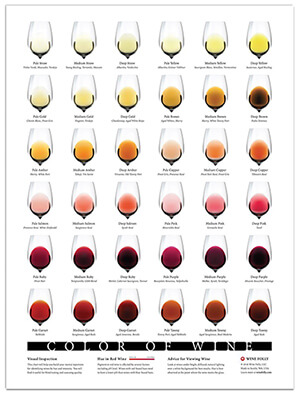Restaurants, retailers, and wine shops have been color-classifying wine for years: red, white, and rosé.
However, a wine’s color is more important and far more complex than three simple categories on a supermarket shelf.
Observing a wine’s color can be a valuable clue for determining the vintage, asessing the wine’s quality, and (most importantly) kicking butt on a blind tasting challenge!
The Complete Wine Color Chart shows 36 unique color states of red, white, and rosé wines, which are organized by hue and intensity. Use this chart to become familiar with the full color hue spectrum that you can observe in a wine glass and to pick up the specific terminology that we can use to describe a wine’s color.
Wine Color Facts
Here are some fascinating details about color in wine.
- Red wines lose color as they age, turning more garnet in color and eventually turning brown.
- As much as 85% of anthocyanin (the color pigment in red wine) is lost after 5 years of aging (even if the wine still appears quite red).
- White wines darken as they age, turning a deeper gold or yellow color and eventually turning brown.
- Red wines that are more opaque generally contain higher levels of tannin (Nebbiolo is an exception to this rule).
- Red wines with higher sulfite additions have reduced color intensity.
- Red wines fermented at higher temperatures will have reduced color intensity.
- Rosé wines are stained pink by macerating the skins of red grapes over an average period of 4 hours to 4 days.
- Oxidation in wine causes it to become brown (like an apple left out on the kitchen counter too long).
- The hue in red wine is partially affected by the pH level of the wine. There are many variables that will affect the color (such as co-pigmentation, sulfur additions, etc.) but the following is generally true:
- Wines with a strong red hue have a lower pH (high acidity).
- Wines with a strong violet hue range from around 3.4–3.6 pH (on average).
- Wines with a blueish tint (magenta) are usually over 3.6 pH (lower acidity).
Get The Color of Wine Poster
We obsessed over color-matching to give you an accurate representation of wine colors. Printed on FSC paper in Seattle, WA.

